An interview with Martine Neddam by Annet Dekker
You studied literature, language, architecture / décor and sculpture and you have a long career in public sculpture. In the early days of the Internet you created your first virtual character, Mouchette. What made you choose this medium and what interested you so much in the Internet?
My background has always influenced my work, especially the literature studies I undertook in France. I started working as a stage designer after my studies and together with a group of friends we made abstract theatre. The plays were not about the situation, but focused on the presence of the actor and speech. This idea of language, of the act of speech transforming the space is still something I strongly believe in and I have continued working with. For the public commissions I was given I also worked with language and text. As with a theatre play I didn’t necessarily go into what the play said, but interpreted and imagined another perspective for the situation. For example, the space of a square or roundabout is a given and spatially you can’t change much, but by simply renaming the space with a sign you can change the mental perspective people have on it. I also applied this way of working in the gallery and the museum space. Language was my material. I would use expressions and stage them in a certain way. For example, I would write a text on the floor that would only make sense when someone walked on it.
I was quite particular in the type of texts I used, because I was interested in modes of address. I didn’t do poetry or narratives, but confronted people by using the ‘I’ and the ‘you’. Probably affected by my previous experience in linguistics and in stage design, I was very much interested in speech acts and what happens between the sender and the receiver of the message. At times I used offensive text with the purpose of analysing something – not the meaning but the mode of address. I wanted to trigger an emotional response within the safety of the walls of the art institute. Public space was of course much more restricted. But there I very much enjoyed the first hand reactions from people. To me public space has always been about public and less about space. Everything that I made and designed was in relation to a certain public. I regard a public space as a public situation. The work of art is the relation you create between you and your public.
And then the Internet came…
It was fascinating; it was a dream come true. All of a sudden you could address and be addressed. When you create a work you can more or less imagine people’s response in your imagination, but you’re not there when they are doing it. And suddenly there was the possibility of being there when they talk back; being there and not there at the same time. That was utopia, one of very few moments in one’s life when that happens.
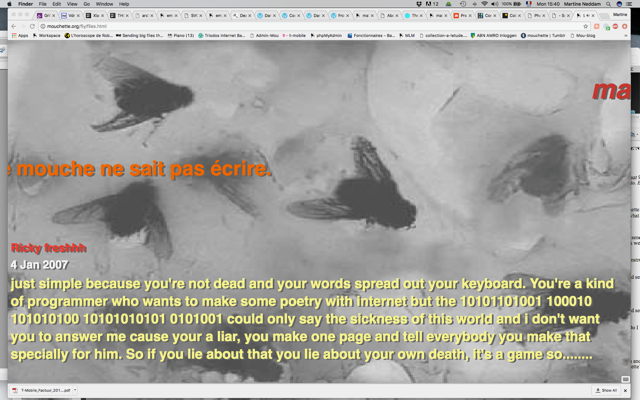
How do you see your position in those early days, within that community?
Many people were creating tools to transform the web and they also made them available to others. The web was exciting because it was something you received, and that you could also pass on. It resembled a gift economy and art was more than an aesthetic enterprise. My personal interest was less in creating technical tools and more in analysing forms of communication. I made my first, very primitive web pages in Mouchette in HTML. When users wrote back I would edit that into HTML pages and post them into my site. In 1998 I commissioned an interface with PHP and that result very much resembled a hand-made blog – one of the first blogs. Artists were really on the frontline.
Something I still preserve as precious was the invention of navigation in a text by means of ‘links’, and in that way going from a web page to another web page. ‘Hypertext’ was a word people often used at that time. It showed how much the web was perceived as a modification inside the structure of a text, breaking its linearity. After a while more features were introduced, for example ‘frames’. This made it possible to organise circulation in several pages. I wanted to get the viewer lost in a very complex navigation, where the placement of the links was invisible or unexpected. To me it was very important to keep the web navigation very organic, a mixture of the expected and the unexpected.
This search and interest in the unexpected is something that I don’t see much any more. In the beginning it was everywhere because everything was a surprise. At the moment it seems that few people are on the net to have an unusual experience or to be surprised.
It seems the Internet has lost much of its original energy and optimism. How would you describe the internet at the moment?
Ruled by commercial purposes, with very little private initiative and over designed. Of course it has reached a certain development, especially in the network features and in the way people communicate with each other. But the visual quality and diversity is poor. It is also evolving in a dangerous way because users don’t own their content on most public platforms and it often ends up being used for commercial purposes. Few people are aware of the consequences of Facebook owning their content. Web pioneers were extremely aware of these things. We were asking ourselves moral questions about every interaction because they were new and every action could become an issue and raised questions. That is why it is so important to keep these origins alive because it preserves the traces and the original dreams.
Very few people recognise why the commercial tools are made and to what end. Maybe the role of the artist is to show that. I still see a lot of creative tools made by individual artists and some are very interesting, but they are hardly discussed in fora, even though they are easy to use and could be useful for designers or a general public. Nobody seems to be interested. The biggest problem is the invasiveness of the large companies. The voices of non-commercial innovation are too small to get heard. This is where the small creative networks have to find a solution because huge networks are swallowing them; they get pushed aside and become invisible.
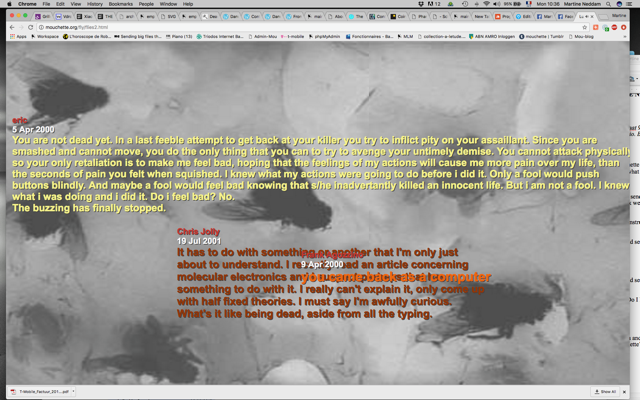
If you look at your different characters, Mouchette, David Still and so on, what is the relationship between them?
With Mouchette I didn’t really have any plans, I just started from scratch: what name do you want to give yourself? Something everyone experiences when you choose an email for example. Starting from that and building up was completely organic. Mouchette was really a mixture of my own fantasy and what the web was becoming. The element of the unexpected was very important in the site and still exists because it has this confusing navigation and it is based on playfullness and surprise.
David Still (2001) was a consciously designed tool for a public I knewi. I wanted to observe how people would use this tool. I created David Still both as an online and offline character, as if he lived in the real world. Originally it was a work I did as a public commission for the city of Almere as a representation of the public sphere there . I used certain aspects of the city, like buildings – David Still lives in a street called ‘De Realiteit’ [the reality], which is an architectural experiment in Almere. So it was both reflecting on the public space in Almere as well as on the public space on the Internet.
I had to end David Still’s main function, sending emails from his email address, in 2005 because spam has become such an overwhelming phenomenon that it made it impossible to send messages from an unknown source. Spam started to rule our email exchanges and from that point on David Still was no longer viable – nobody wanted to hear about an unknown person. Different web hosts around the world came up with different legislations against spam and I had to change hosts three times, eventually disabling the send function.
The Virtual Person project that I started in 2008 is also a tool; an experiment with web design and personal expression. The Internet is very much developed as far as networking, dialogue and exchange goes, but there are very few tools for personal expression. Virtual Person.net is a limited tool, because I wanted to make it as accessible and usable as possible. It focuses on certain visual features that I think are meaningful to develop, for example fading one image into another instead of linking them. When you make something with many functions, people use the one by default because there is too much choice, blogs for example are a clear example of this. People who design it say you can do many things with it but users ultimately only use default functions. The result is uniformity.
Most of all by creating VirtualPerson.net I wanted to offer the use of visual features that haven’t been explored; a mixture of text and image in a visual composition. I believe this is an area with huge potential but at the moment texts and images are still treated as separate. They never really merge onto the same surface, contradicting each other or intertwining in a way that creates a different meaning. In Facebook and blogs you can upload image and text separately but it is not possible to combine them in more sophisticated ways. These interfaces are not designed as creative tools. I want to explore the relation between the two in a consistent way. It follows my previous works in the public space and the visual design of Mouchette.
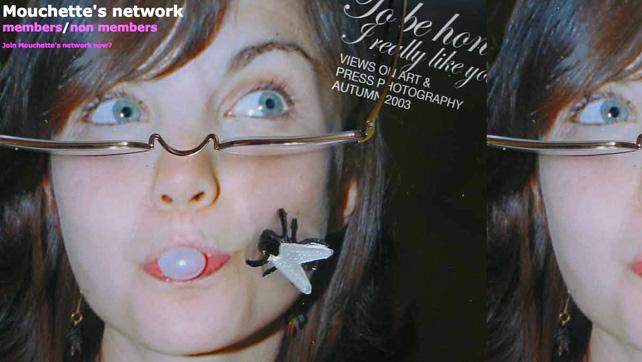
In a way your online work is emblematic of the Internet; reacting to communication systems, issues of identity, spam, image and narrative tools, etc. But also the technical side is highly developed, even though the websites look very easy in set up and design, they were made with state-of-the art technology, mostly adapting and programming existing or new programs and software. Whereas most net_art is known for its innovative use of technology your work is never really mentioned in this respect nor did others ever reflect upon it. Why do you think that is?
I never liked to use technology as the subject of my work. But indeed if you are not interested in technology you can’t work with the web as a medium. From the start I was very close to the new technological developments. Web editing was available to everyone, and when new features appeared in the browser, artists were the first to use them while commercial sites had to wait six months before they could implement them. Artists could create something within half an hour, giving it a certain creative spirit. That may not be the case anymore. At the moment large companies invest huge sums in experimenting and are much faster in finding new solutions than before. But I wouldn’t say that this is innovation: Innovation is not necessarily building on something but it is about questioning, for example how you to not use something. You try to think of something in a different way, that is where innovation comes in.
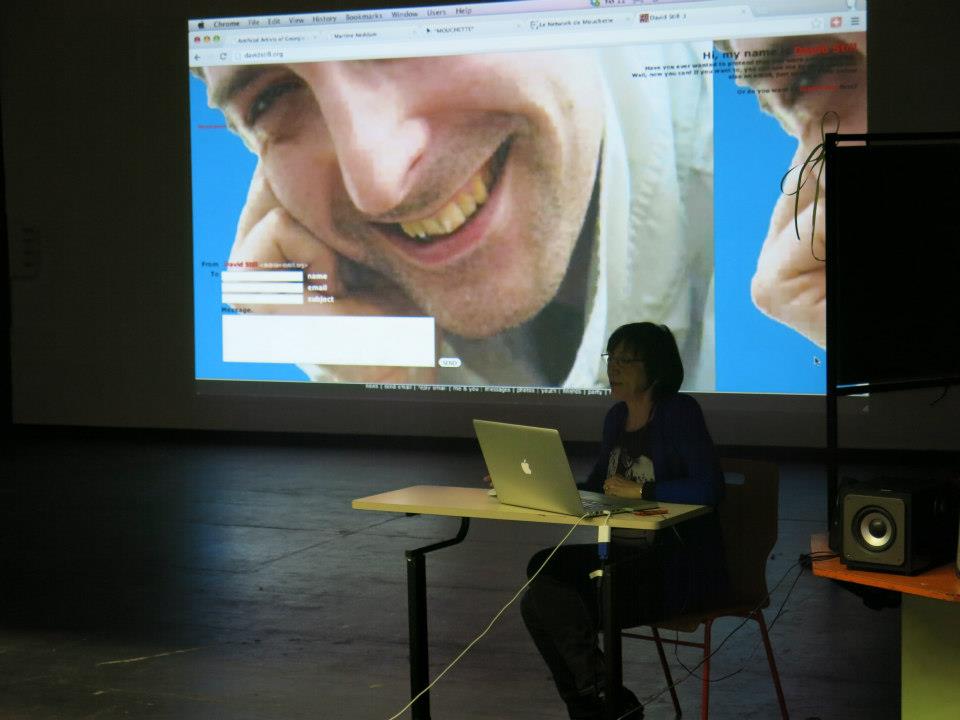
You made work especially for the Internet, but could you see the work presented on other platforms – pubic (urban screen / mobile phone) or private (gallery/black-white cube)?
Mouchette has always existed in the public space as a collection of different works of art. It wasn’t always easy to exist simultaneously on the Internet and in the world of art. Sometimes I was invited as Martine Neddam and I would ask the museum to present it as Mouchette and to become the accomplice so as to keep the author anonymous. Not everyone accepted, because these were not easy or obvious conditions. But some did and I created installations in the gallery, soundworks, a shopping bag as part of an art manifestation in a shopping mall, etcetera. I used all the existing media and materials available to communicate. I don’t see the Internet as separate from other media, it is just one of the tools. But it still depends very much on my own energy to keep Mouchette connected to the world of art. Most curators don’t think about the possibility of showing art created for the Internet, let alone in another media.
What about using mobile phones, a communication medium that has integrated, text, photo, video and internet, as a platform? It seems an ideal combination.
It is tempting to make special work for mobile phones, but it is still difficult to integrate and to circulate it through various mobile networks. You used to have WAP and Palm, but after one year the technology disappeared. The thing with these mobile devices is that they are enormously controlled and you have to go through so many layers in order to get something out to the public: the whole system is build to limit the possibilities and the creativity of the user. The web wasn’t like that. Suddenly, from one day to the next it was in the hands of the user. That particular freedom is essential if you want to create something.
And what about Urban Screens? People are also referring to them as large communication platforms.
Yes, I would love to experiment with that. For Virtual Person I was tempted to bring it into the public space, and billboards and other screens in the public space seemed a logical place. But there are so many limitations. First of all it would be really difficult to carry out tests and secondly I realised that I would lose intimacy. The physical distance from the body to the screen for example is very important to take into account. It makes a huge difference in impact and experience on the body if you have 1.50m (the television distance) or 50cm for a computer screen, 20 cm for mobile devices or 20 meters minimum with urban screens.
Urban screens have totally different parameters; it is a medium in itself – the distance to the viewer, the scale, the lack of sound, etc. It relates more to billboards and advertising than to internet or mobile phones. Artists have to be commissioned for the situation. Because the advertising space is expensive, it becomes very difficult to experiment freely with the medium and develop a specific language.
How do you see the relationship between the virtual and the real – also in a more bodily/emotional sense? David Still to me was almost tactile, someone very close to you, maybe because he addressed you in a very personal way. Virtual Person is now a tool for making your own Virtual Person.
Virtual Person is about text and image correlation and I would like to make that relation more physical. I am very interested in using touch screens. I would love to embody the connection between texts and images. The act of touching a screen generates a completely different experience than the use of a mouse, even though the use of a mouse is a tactile experience, it emphasizes more directly the bodily experience of the net. I don’t believe that the internet excludes our bodies. Nobody teleports, we still look at the screen using our physical body, with our spine straight or crooked, and with our hand moving and touching. We use our body to inform us about our non-body experience.
Mouchette for example is very much designed from the body on. I would mirror my own situation, my body to the screen, posing an imaginary situation where the viewer and I are mirrored on both sides of the screen, like in the work ‘Flesh&Blood’. When I used sound I recorded it close to the microphone to create that intimacy. The low volume involved the body of the viewer in the act of listening. The Internet is an extension of the body and an out-of-the-body experience, all in one. People tend to say that their body vanishes in the net, but this is precisely that experience that we act out with our body! The fact that your gender is invisible online is a body experience; when does that happen in real life? Many of the early Internet works play precisely with the physical experience of the disappearance of the body. This is why I think it is so important to keep the old examples alive because they bear the trace of the most important discourse on Internet which is still valid but might disappear in the evasiveness of the internet.
As said before, the biggest challenge for the internet today is finding these ‘invisibilities’.
Yes, and in that way I would say that the institutions are not doing their work. They should keep track of these early creations. Some do, like Rhizome, Turbulence or Eyebeam, but there should be more attention in renewing the interest of the public, for example by presenting works again in new contexts or wider contexts.
Another concern is the missing link between the works of net_art and the public. In the beginning the artists did everything by themselves but at the moment that has become more difficult, leading to unstructured relations. This should be one of the tasks of the museums and art institutions and it is not that much work; posting one item a day would suffice. Valuable works of art are already disappearing. Work that I bookmarked two years ago has been taken off because someone did not pay the server costs or the domain registration or couldn’t keep up the maintenance. These are simple things, much cheaper and easier to do than storing a painting or a sculpture in a storage room, and need to be done otherwise many creative possibilities disappear from our landscape and our memory.
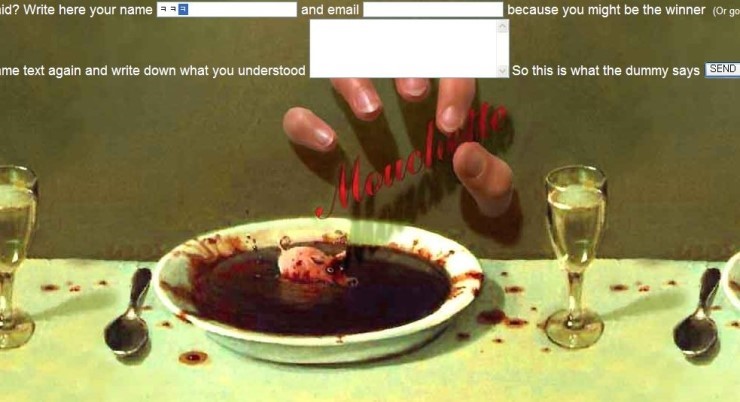
How do you deal with the speed of change on the Internet, especially for your older sites like Mouchette?
There are different levels. Some of the changes are very hard to keep up with, for example the scripts; by changing platforms and operating systems the scripts become less compatible. Suddenly a certain script doesn’t work on a new version of a browser for a certain platform and then some viewers will not see the work as it was meant to be. This is not a new phenomenon, compatibility has always been one of the main issues of the net, but the changes are hard to keep up with. To have a 100% successful viewing you need to create a different version for each configuration, which is a highly technical solution and needs to be re-adapted constantly. I would love to have it done, but I can’t pay for it and at the moment there is no funding for pure maintenance. One year ago I stopped creating new works for Mouchette but I am still working 10 to 15 hours a week to keep it alive, maintaining domains, re-registering etc. If nothing happened the art would die. I have complex scripts that address people one by one and they still function because I know their failures, I keep an eye on it and fix the little mistakes by hand when they happen. It is a very personal use of low technology; everything is made with small pieces of fabric, like a patchwork.
People also regard the internet as virtual, and they believe it means ‘immaterial’ but it is not. Your imagination transforms into actual matter: bits on a server. A computer changes matter into visuals and words. The virtual world consists of bits and pieces: the internet is material, you can break it and make it disappear; that is the reality of the virtual. When you realise how much data Google is saving, that is an enormous conservation of hard disks in large rooms. Maybe when people start to see that the internet is material they might value it more, or treat it in a different way.
i People could send emails coming from David Still to others, thus using his identity.
View the pdf of “In search of the Unexpected”
In Search of the Unexpected, a conversation with Annet Dekker, as a pdf document
2009 navigatinge-culture.PDF is the complete the PDF document. The texte is page 33 to 37